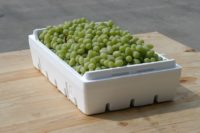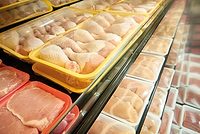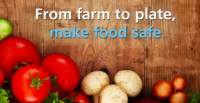In the food packaging industry, food safety is a top priority in everything we do. In addition to producers and retailers, who depend on food safety to deliver responsible products that build and secure their brand reputations, there’s also an ever-increasing expectation from consumers that their food products are safe to eat. In fact, consumers today place concerns over food safety and food waste above climate change, air pollution and water shortages, according to a 2014 Harris Poll consumer food waste study.[1] But food safety has long been top of mind. The year 2016 marked the 75th anniversary of Henry DePoix’s original innovation of shrink wrap technology—pioneered at the onset of World War II as a better way to preserve meat for French soldiers and first introduced to the market by Cryovac®. Today, the industry continues to develop better packaging to meet new food challenges.
Two key issues—food safety and food waste—are inextricably linked. We as an industry shoulder a big responsibility to deliver effective outcomes and provide consumers, retailers and processors with peace of mind about the safety and sustainability of the food they process, pack, sell and consume. With that framework in mind, Sealed Air took a look at one of its innovative solutions: Darfresh® on Tray—a sustainable vacuum skin packaging system for fresh red meat and poultry—in the Darfresh on Tray Meat Packaging Economic and Sustainability Impact Study.[2]
Preventing Unhygienic Leaks
By delivering products in packaging that prevents unhygienic leaks and cross-contamination, vacuum-seal technology can protect food at all stages of the food system journey. Packages like Darfresh on Tray are designed to lock in juices for fresh red meat and poultry products. The process not only improves the product quality for the final consumer but prevents harmful leaks.
The new system uses specially formulated top film and bottom tray to create a vacuum skin consumer pack that fits the product like a second skin. The top film seals firmly but gently around every contour of the product without distorting its shape. The top web and tray are then heat-sealed together right up to the product’s edges to produce a securely and hygienically sealed pack.[3]
This innovative system and its tight, second-skin seal means improved hygiene and a reduction in cross-contamination risks. The package eliminates messy, unsanitary leaks that could compromise safety during transportation, display or after final purchase.
Reducing Re-Packaging
Food processors and retailers are diligent about addressing food safety concerns, but food safety challenges can also occur in homes after a consumer has purchased a food item. Unknowingly, consumers can compromise the integrity of their freshly purchased food by repacking it themselves. For example, it’s common to divide a meat or poultry package into separate portion sizes to freeze part of a larger pack, which undermines the original packaging’s role in ensuring food safety.
To combat this practice and preserve food safety, processors should consider freezer-ready packaging that comes in multiple or individual-sized options, and clear packaging that communicates the product’s integrity and transparency, bolstering consumer confidence. Darfresh on Tray was engineered to meet these modern consumer desires. The package is not only leakproof but freezer-ready, transparent and available in multiple sizes.
Extending Shelf-life
While consumers may not fully understand the role packaging plays in shelf-life extension and food safety, retailers certainly do—a fact that processors should take note of. In fact, the Darfresh study cites an important finding: 56 percent of retailers said improved packaging is an important factor when it comes to reducing waste.[4]
The same innovative packaging system that reduces leaks also contributes to increased shelf-life that ultimately reduces waste. In studying the effect of the product, Sealed Air found that:
Non-vacuum packaged meat has only two days to get to the retailer and has a shelf-life of two to four days in the refrigerated display case. For a typical mother bag packaged meat product, processors have eight days in a dark refrigerated storage during distribution and two to four days in the refrigerated display case. Darfresh® on Tray, on the other hand, can be stored up to 15 days in dark, refrigerated storage, and has from five to eight days of life in the retail case.
It’s well known that food safety and waste pose serious challenges to the industry. But by improving food safety outcomes, effective packaging can simultaneously help to reduce waste and increase sustainability throughout the supply chain. Darfresh on Tray delivers shelf-life extension for poultry and can nearly double the shelf-life for fresh red meat. This is especially relevant given that, according to the U.S. Department of Agriculture, 2.7 billion pounds of meat, poultry and fish valued at $8.8 billion, equal to almost 5 percent of the category inventories,[5] are thrown out by retailers each year—in addition to the large amount of product wasted by consumers themselves.
(Shrink) Wrapping it All Up
We’ve come a long way since the creation of DePoix’s shrink-wrap technology, but today’s conscientious consumers expect more than improved safety from their food providers. They expect packaging and products that not only keep their food clean and safe, but also protect the environment by delivering sustainable solutions. By increasing food safety and therefore reducing food waste, innovative packaging can reassure today’s concerned consumer and help create better brand awareness and reputation for those who offer it.
Sean Brady is a market development manager for Sealed Air.
References
1. Nielsen. Consumers and Food Waste. Harris Poll survey on behalf of Sealed Air of 1,005 adults who do at least 25 percent of their households shopping between April 18 and April 25, 2014.
2. https://sealedair.com/food-care/darfresh-on-tray.
3. https://sealedair.com/food-care/darfresh-on-tray.
4. https://sealedair.com/food-care/darfresh-on-tray.
5. Buzby JC, Wells HF, Hyman J. The Estimated Amount, Value and Calories of Postharvest Food Losses at the Retail and Consumer Levels in the United States. U.S. Department of Agriculture Economic Research Service. Economic Information Bulletin No. 121, February 2014.



